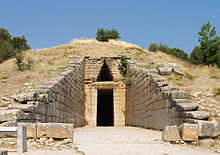Τάφος του Αγαμέμνονα | |
 The dromos of the Treasury of Atreus | |
| Location | Mycenae, Greece |
|---|---|
| Coordinates | 37°43′37″N 22°45′14″E / 37.72682°N 22.75387°E |
| History | |
| Material | Poros stone, conglomerate, marble. |
| Founded | c. 1400 – c. 1250 BCE |
| Periods | Late Bronze Age |
| Cultures | Mycenaean Greece |
| Site notes | |
| Excavation dates | 1801–1955 |
| Archaeologists | Heinrich Schliemann, Panagiotis Stamatakis, Alan Wace |
| Public access | Yes |
| Designated | 1999 |
| Part of | Archaeological Sites of Mycenae and Tiryns |
| Reference no. | 941 |
The Treasury of Atreus or Tomb of Agamemnon[1] is a large tholos or beehive tomb constructed between 1300 and 1250 BCE in Mycenae, Greece.[2]
It is the largest and most elaborate tholos tomb known to have been constructed in the Aegean Bronze Age, and one of the last to have been built in the Argolid. The main tomb consisted of a circular burial chamber, or thalamos, topped with a corbelled dome. This dome was the largest in the world until the Roman period, and remains the world's largest corbelled dome. Originally, the façade was decorated with marble columns and sculptures, which used marble from the Mani Peninsula in the southern Peloponnese. Its artwork has been suggested to have been inspired by that of Minoan Crete and of Ancient Egypt.
Little is known of the persons who might have been buried in the tomb: the identification with the mythical Atreus and Agamemnon likely dates to the 18th century. The immense labour involved in the construction of the tomb, as well as the similarities between the architecture of the tholos and the structures of the citadel of Mycenae, has led to suggestions that it may have been intended for a ruler of Mycenae, and represent Mycenae's increasingly dominant status in the later part of the Bronze Age.
The tomb was first excavated in the 19th century, when parts of the marble sculptures of its façade were removed by the British aristocrat Thomas Bruce, 7th Earl of Elgin and the Ottoman governor Veli Pasha. It was partly excavated by Heinrich Schliemann, and more fully by Panagiotis Stamatakis, in the 1870s. Throughout the 20th century, the British School at Athens made a series of excavations in and around the tomb, led by Alan Wace, which primarily aimed to settle the difficult question of the date of its construction.
